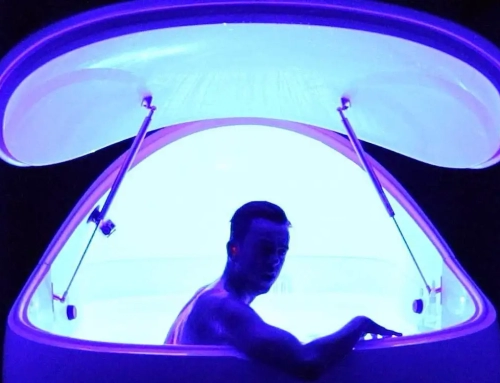To purchase GIFT CARDS from Salt Float Studio ~ please click HERE!
To visit Salt Float Studio’s PRICING page ~ please click HERE!
Floatation therapy is said to be an effective yet incredibly simple way to boost your health and happiness. It’s a type of sensory deprivation treatment that’s achieved by floating in an enclosed, isolated tank that cuts off all sensory experiences: sight, smell, touch and sound. The tanks used are filled with water that’s nearly the exact same temperature as a floater’s body, obscuring the normal sensation of having discrete limbs in space. Combined with a high amount of Epsom salt, it allows one to remain peacefully floating at the water’s surface, immersed in the stillness and total silence. It takes no effort whatsoever to stay afloat, resulting in a light peaceful feeling, which is said to provide many beneficial impacts to the body and the mind.
These float tanks, once popular only with the sort of people who enjoy polishing chakra crystals and getting stoned, have now reentered mainstream culture, becoming increasingly popular for sorts of users who want to experience their therapeutic effects. Now you can visit one just like you would a spa, it will not only enhance the body but the mind too.
It’s Probably Not What You Imagine:
Unlike what you might think, with floatation therapy, you don’t have to worry about getting claustrophobic as you’ll have plenty of room. While the floatation chambers used to be like tiny tanks, that’s no longer the case. In fact most are quite a bit longer than one’s height, and the ceilings are tall enough that you could stand up in one and not hit your head, but of course, you wouldn’t do that anyway, the whole point is to lie down, relax and let the water carry all that mental clutter away. It’s also totally private, so you can do it naked if you want to, and for all you OCDers out there, the process is very clean, thanks to systems that purify the water multiple times between every user, running it through a high-tech UV disinfection process.
How It All Began:
The invention of floatation tank therapy is attributed to postwar researcher John C. Lilly, a neuroscientist who became convinced that the brain of a dolphin contained supreme intelligence that humans could utilize in order to solve all types of problems. In the 1950s, he constructed what were basically water-filled living rooms, so that he and his colleagues could live with the creatures, and even cultivate what he’d hoped would become a common language. He began further sensory deprivation experiments in the 1960s and ’70s under the influence of LSD and ketamine, known for creating a trance-like state while providing pain relief and sedation. In the ’80s, the tanks fell out of fashion, mainly because of the AIDS panic, as people were unsure as to how the illness was spread and were fearful of contracting the disease, but in recent years they’ve regained their following with many enjoying the wealth of benefits derived from floatation therapy, including the following.
10 Benefits Of Floatation Therapy
1. Improving Sleep
If you suffer from insomnia or other sleep issues, it can bring many detrimental effects into your life. Getting quality sleep on a regular basis helps to ensure that your brain functions at its best, allowing you to make better decisions, resolve problems, remain more emotionally stable, improve focus, and more. It also puts you at a lower risk of developing infections and certain illness too, like hypertension, stroke and heart disease. Floatation therapy can help. Research has found that floating just two hours a week for two weeks may bring improvement in insomnia symptoms. It restores and refreshes the senses, leaving one rested, relaxed and able to forget about those worries and finally enjoy a good night’s sleep. Even if you don’t generally experience sleep problems, after a session you’re likely to find that you sleep much deeper, and feel much more rejuvenated and restored the next day.
2. Stress Relief and Treating Stress-Related Illness
Floating therapy is said to be an antidote to stress, thanks to it providing a deep sense of relaxation and inner peace. Many users even say that colors seem more vibrant, and you might suddenly notice more about your surroundings, kind of like someone who just got their first pair of corrective glasses after having hazy vision. While these types of benefits can be difficult to prove, research is beginning to show how it works, revealing that it can be an effective, non-invasive way to treat pain and illnesses that are related to stress. In fact, a Swedish study published in the Journal of Complimentary & Behavioral Medicine in 2014, suggested that it may work by reducing the body’s stress response, which induces deep relaxation.
3. Treating Fibromyalgia
As just mentioned, floatation therapy may help treat stress-related illness, and that includes fibromyalgia. That because a flat session reduces markers of bodily distress syndrome (BDS) which is often used to describe the negative physiological changes that occur when one is under a significant amount of stress. Signs of BDS have been linked to fibromyalgia symptoms as well as chronic fatigue syndrome. A study that was presented at a 2012 floatation summit in Sweden showed “compelling evidence” that floatation therapy, also referred to as Reduced Environmental Stimulation Therapy (REST), can have a “beneficial impact” on those who suffer from fibromyalgia. The researchers discovered that there were “significant temporary reductions in pain, muscle tension, stress, anxiety, and sadness, as well as significant increases in relaxation, feelings of well being, energy and ease of movement. There was also a significant improvement in the quality of sleep.”
4. Pain Relief
Even if you don’t suffer from a condition like fibromyalgia, you’re likely to experience pain relief. In fact, you’re like to find that it relieves pain you didn’t even realize you had. Many people suffer from tension and stiffness in places like the lower back and shoulders, but by the end of even just one session, it becomes practically nonexistent. Both patient testimonials and multiple studies have suggested that float therapy might serve as a natural pain killer as the primary way it helps relieve pain is by evoking the relaxation response, which is known to improve recovery and ease tense muscles.
In fact, research that examined the effects of placebo treatments as compared to floatation therapy showed that the floating sessions relieved muscular pain related to stress in patients suffering from burnout depression. Patients that underwent therapy for six to 12 weeks, had less pain, as well as reduced blood pressure levels, more energy, less anxiety and lower stress levels.
5. Reduced Anxiety
Nearly one in 5 adults in the U.S. suffer from a type of anxiety order, including general anxiety disorder (GAD). It’s not only widespread, but it’s one of the most difficult health conditions to treat. Floatation therapy may be able to help, as just recently, researchers from Sweden’s Karlstad University tested its effects on anxiety disorder symptoms. They found that symptoms had significantly changed for the better following 12 sessions of the therapy over a four month period. Over one third who were treated were actually reported to be in full remission of their symptoms, and the majority of the other participants experienced at least some beneficial effects related to regulating emotion, depression and/or sleep problems. At the six-month follow-up point, all were still experiencing improved outcomes.
6. Magnesium
According to the World Health Organization, some three-quarters of adults don’t get enough magnesium in their diet, a mineral that’s essential to many body processes. In fact, a lake of magnesium has been associated with many different adverse health effects, including headaches, hypertension, diabetes and the development of heart disease. It’s also important for bone growth and can affect athletic performance too, which is why many athletes favor it as the body can absorb magnesium from the Epsom salt-infused water, which helps to facilitate flushing of lactic acid from tired muscles, allowing them to recover from an intense workout faster.
For hundreds of years, bathing in Epsom salt was used therapeutically, and one of the primary reasons it was so healing was because it naturally increases magnesium levels. It may also be at least partly behind the reason it’s so effective for treating insomnia. Magnesium has been found in multiple studies, including 2009 research from the Medical University of Lublin in Poland, to help one sleep due to its ability to relax GABA receptors in the brain and the nervous system, promoting a sense of calm and virtually slowing down the mind and body so that you can relax enough to fall asleep. You may also find that your complexion has improved, you feel less anxious and your blood pressure is at a more optimal level, along with many other positive impacts getting enough magnesium can bring.
7. Better skin
Your skin is also likely to thank you for enjoying a floating session, which is mainly due to the Epsom salt. Magnesium sulfate is a natural exfoliator that can help remove dead skin cells to reveal the clear, glowing skin underneath. It’s also effective for unclogging pores, reducing the number of blackheads and clearing up breakouts. If you suffer from skin conditions like rosacea and eczema, it can help too, thanks to the antimicrobial and antibacterial properties of magnesium.
8. Restoring healthier hair
Epsom salt has positive effects on hair too. Many of us toss all sorts of things onto our locks in the name of beauty from those harsh, alcohol-based sprays and volumizing products to the extreme heat from styling tools. All of that can make damage those tresses, making it look frizzy and dull. A floatation session can help, as the Epsom salt strips gunk from the hair and restores natural time. It also helps to create more volume and the appearance of thicker hair. In fact, some people find that after floating, they can get out and let their hair air dry and it looks gorgeous, kind of like an attractive, just came back from the beach look.
9. A break from those electronic gadgets
When was the last time you took a real break from all of those screens that you stare at every day, from your smartphone to your laptop and television? We all need a break from those screens now and again as our world is more wired than ever. Our minds are constantly on the go, and without a break, it can often lead to lower productivity and even burnout in the long run, in addition to negatively affecting emotional and physical health. The brain needs time to rest and recover – not just while you’re sleeping. All of that multitasking can actually cause the brain to overheat, similar to what happens with a car engine. Floatation therapy provides that all-important break, allowing you to slip deeper and deeper intorelaxation, forgetting about those worries and even becoming totally unaware of the passage of time, like a mental detox. This is a huge benefit for most people, but especially Type As, those that feel obligated to constantly respond to every email and text, or risk feeling “frantic, frazzled, frenzied.’ Taking time to de-stress through floatation therapy means everything gets improved: your enjoyment of life, your physical and mental health, and your longevity.
10. Overcoming addiction
A study in the early 1990s from the REST Research Lab focused on identifying how effective this type of sensory deprivation therapy might be for overcoming addiction found that it can be a ‘versatile, cost-effective treatment modality with demonstrated effectiveness in modifying some addictive behaviors, and has promising applications with others.” Participants who were struggling with addictions to drugs, alcohol and/or nicotine, experienced improvements linked to either rebalancing a variety of physical and mental effects related to stress, or the refocusing of the mind. The researchers found that it helped them to overcome their addictions by providing relief through a non-chemical technique, inducing the general relaxation response, helping them to internally refocus so they could concentrate on resolving personal problems, and disrupting habits by removing trigger cues and response possibilities as well as improving feelings of control over addictive behaviors.
September 11, 2017 by






